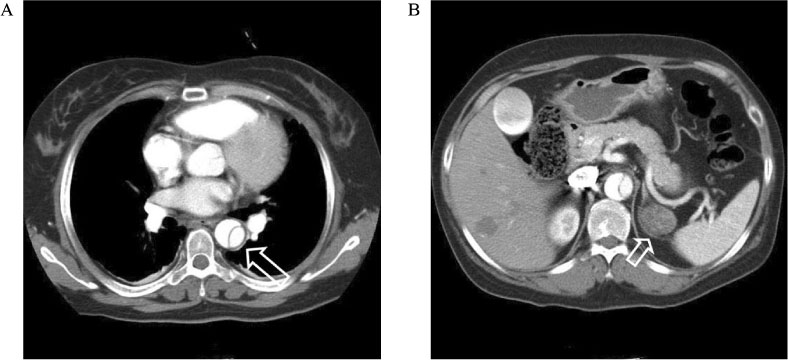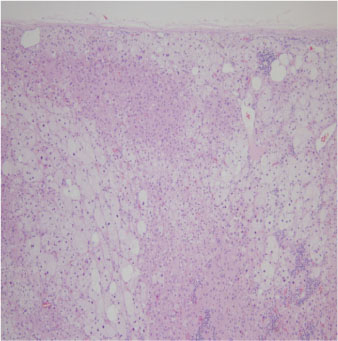J Korean Endocr Soc.
2006 Dec;21(6):556-559.
A Case of Aortic Dissection Associated with Cushing's Syndrome
- Affiliations
-
- 1Department of Internal Medicine, Seoul National University College of Medicine, Korea.
Abstract
- Herein is reported the case of a 43-year-old woman, who experienced an acute aortic dissection associated with underlying Cushing's syndrome. The patient had central obesity and a moon face of ten years duration, but had never sought medical consultation. On the day of her presentation, she experienced a severe chest pain radiating to her back. Computed tomography revealed a Stanford type B acute aortic dissection and a left adrenal mass. From her hormonal study results, clinical symptoms and signs, she was diagnosed with Cushing's syndrome, which was due to a left adrenal adenoma. After medical treatment to stabilize the aortic dissection, she underwent left adrenalectomy. The aortic lesion of the present patient suggests that hypercortisolemia arising from Cushing's syndrome might be related to the development of acute aortic dissection.
Figure
Reference
-
1. Nienaber CA, Eagle KA. Aortic dissection: new frontiers in diagnosis and management: Part I: from etiology to diagnostic strategies. Circulation. 2003. 108:628–635.2. Green GR, Kron IL. Cohn LH, Edmunds LH, editors. Aortic Dissection. Cardiac Surgery in the Adult. 2003. New York: McGraw-Hill;1095–1122.3. Takagi H, Furukawa M, Umeda Y, Fukumoto Y, Yoshida N, Yamada T, Mori Y. Aortic arch aneurysm with dissection in Cushing syndrome. J Thorac Cardiovasc Surg. 2004. 127:278–279.4. Lawrence J, Zimmerman H. Pituitary basophilism. Report of a case. Arch Intern Med. 1935. 55:745–749.5. Suzuki T, Sasano H, Murakami O, Nagura H. A case of ruptured dissecting aneurysm 5 years after pituitary microsurgical treatment of Cushing's disease: autopsy findings in the hypothalamic-pituitary-adrenal axis. Endocr J. 1993. 40:613–618.6. Aoyagi S, Akashi H, Otsuka H, Sakashita H, Okazaki T, Tayama K. Acute type A aortic dissection in a patient with systemic lupus erythematosus. Jpn Heart J. 2002. 43:567–571.7. Steffee CH, Snell KC. Dissecting aortic aneurysm in hamsters treated with cortisone acetate. Proc Soc Exp Biol Med. 1955. 90:712–714.8. Valigorsky J. Metaplastic transformation of aortic smooth cells in cortisone-induced dissecting aneurysms in hamsters. Fed Proc. 1969. 28:802.9. Reilly JM, Savage EB, Brophy CM, Tilson MD. Hydrocortisone rapidly induces aortic rupture in a genetically susceptible mouse. Arch Surg. 1990. 125:707–709.10. Leibovich SJ, Ross R. The role of the macrophage in wound repair. A study with hydrocortisone and antimacrophage serum. Am J Pathol. 1975. 78:71–100.
- Full Text Links
- Actions
-
Cited
- CITED
-
- Close
- Share
- Similar articles
-
- A Case of Cushing's Syndrome
- Acute Type II Aortic Dissection with Severe Aortic Regurgitation and Chronic Descending Aortic Dissection in Pregnant Patient with Marfan Syndrome
- A Case of Cushing's Syndrome caused by Adrenocortical Carcinoma
- A Case of Dissection in Marfan Syndrome with Ascending Aortic Aneurysm
- A Case Report of Acute Type II Aortic Dissection in a Patient with Marfan's Syndrome and Who Was 24 Weeks Pregnant: A case report



